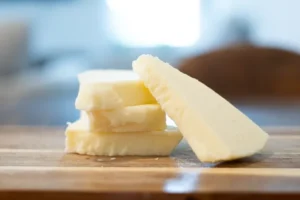Table of Contents
Beef Tallow: Why Our Grandparents Were Right About This Superfat
The Tallow Renaissance: From Forgotten Fat to Modern Superfood
Once banished from kitchens due to misguided nutrition advice, beef tallow is making a remarkable comeback. But this isn’t just nostalgia – modern science reveals what traditional cultures knew:
- Superior stability – Withstands high heat better than most vegetable oils
- Skin compatibility – Molecularly similar to human sebum
- Nutrient density – Packed with fat-soluble vitamins missing in modern diets
- Sustainability – Uses parts of the animal that would otherwise go to waste
According to a 2017 NIH study, traditional animal fats like tallow may be far healthier than the industrial seed oils that replaced them.

Beef Tallow: The Forgotten Superfood for Cooking, Skin Care and Health
What Exactly Is Beef Tallow?
Beyond Simple Fat: A Complex Nutritional Profile
Beef tallow isn’t just “rendered fat” – it’s a complex substance containing:
- Stearic acid (18-22%) – A saturated fat that may improve cholesterol ratios
- Oleic acid (36-48%) – The same heart-healthy fat in olive oil
- Conjugated Linoleic Acid (CLA) – With potential anti-cancer properties
- Fat-soluble vitamins – A, D, E and K2 in highly bioavailable forms
The Grass-Fed Difference
| Nutrient | Grass-Fed Tallow | Grain-Fed Tallow |
|---|---|---|
| CLA | 2-5x higher | Lower levels |
| Omega-3s | Up to 50% more | Minimal |
| Vitamin E | 3-4x higher | Standard amounts |
10 Science-Backed Benefits of Beef Tallow
1. The Ultimate Cooking Fat
With a smoke point of 400°F (205°C), tallow outperforms most oils:
- Creates perfect crispy fries (McDonald’s original secret ingredient)
- Ideal for searing steaks without burning
- Produces flakier pie crusts than butter
Pro Tip: Save bacon fat and tallow in separate jars – they have different flavor profiles for cooking.
4. Skin Regeneration Properties
Tallow’s similarity to human sebum makes it remarkable for:
- Eczema and psoriasis relief (NIH study on skin barriers)
- Reducing wrinkles by supporting collagen production
- Healing cracked heels and cuticles
7. Brain and Nervous System Support
The brain is nearly 60% fat, and tallow provides:
- Cholesterol for myelin sheath formation
- Fatty acids that may protect against neurodegeneration
- Compounds that support neurotransmitter function
How to Make Beef Tallow: Traditional vs Modern Methods
The Old-Fashioned Way
- Source suet from grass-fed cattle (ask your butcher)
- Chop into 1-inch cubes and rinse
- Cook over lowest heat for 4-6 hours (no boiling!)
- Strain through cheesecloth into mason jars
21st Century Shortcuts
- Slow cooker method: Set on low for 8 hours
- Instant pot: 2 hours on yogurt setting
- Oven method: 225°F for 5 hours
Creative Uses Beyond Cooking
| Application | Recipe | Benefits |
|---|---|---|
| Skin Balm | Tallow + lavender oil | Deep moisture + relaxation |
| Leather Conditioner | Tallow + beeswax | Restores suppleness |
| Candle Making | Tallow + essential oils | Clean-burning, no toxins |
Nutrition Myths Debunked
The Saturated Fat Controversy
Modern research challenges old assumptions:
- No direct link to heart disease (American Heart Association updates)
- Stearic acid may improve cholesterol profiles
- Traditional diets high in animal fats showed low heart disease
Tallow vs. Vegetable Oils
Industrial seed oils contain:
- High levels of unstable omega-6 fats
- Processing chemicals like hexane
- Oxidized compounds when heated
Frequently Asked Questions
Is beef tallow good for acne?
Surprisingly, yes for many people:
- Non-comedogenic despite being heavy
- Anti-inflammatory properties
- Helps balance sebum production
How long does homemade tallow last?
Properly rendered and stored:
- Room temperature: 6-12 months
- Refrigerated: 1-2 years
- Frozen: Indefinitely
Conclusion: Bringing Tallow Back
Beef tallow represents a return to traditional wisdom with modern scientific validation. By incorporating this ancestral fat into our lives, we gain:
- A sustainable use of the whole animal
- Superior cooking performance
- Unique health benefits missing from modern diets
As with any food, quality matters – seek out grass-fed sources and enjoy in balance with other healthy fats.